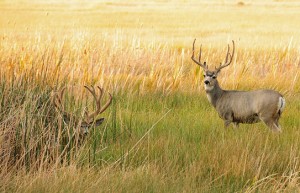Deer Hunting: Five Levels of Alertness
Novice hunters think there are two kinds of deer: spooked deer and un-spooked deer. What they learn over time is that there are many different levels of alertness.
If you get a chance to watch a relaxed deer in his summertime routine, you’ll notice that his ears are low, his eyes are calm and staring straight ahead, and he holds his head in a low and relaxed fashion. An alert buck is the opposite: his eyes are wide, his ears are forward and his head is erect and staring. Now, somewhere between these two opposites is where bucks reside most of the time.
As opening day rolls around, the majority of bucks already know it before the first shot is fired. They’ve heard the trucks and ATVs rolling in and can smell the campfires. Even before hunting season, a buck’s internal clock alerts him to impending danger of upcoming hunting season just by the angle of the sun. Any buck who has survived a few hunts knows that danger starts showing up at the beginning of autumn. Even worse, if there are lots of natural predators around—like cougars and coyotes—then a buck is already living in a state of high alertness at all times. This makes them even more difficult to hunt.
On high-pressured public lands, big bucks live full-time on a heightened level of alertness. Therefore, an accurate assessment your target buck’s alertness level will dictate your approach. For example, if a buck is bedded and alert, then you must be more cautious than when he is dozing off.
Over the years I’ve developed a rating system for assessing a buck’s different levels of alertness. A level 0 means the buck is carefree and happy with no pressure from predators. A level 5 means he’s turned inside out and running for his life. Your job is to figure out what level the buck is on, and adjust your approach accordingly. The following is my alertness level assessment system:
Levels of Alertness in Deer
Level 0
Level 0 is very rare, and basically means the buck isn’t alert at all. This only occurs in totally unpressured areas—such as unhunted private property or very remote country. It can also occur pre- or post-hunting seasons after the buck has calmed down and is in a relaxed routine. Level 0 also assumes that there are very minimal natural predators in the area.
Level 1
The hunting season has begun, but the buck is bedded in a far-away, secure area with the wind at his back. His eyes are closed, ears are pinned back, and he’s chewing his cud. Or maybe he’s sleeping with his chin flat on the ground. Otherwise, he’s up and feeding with a small group (for security). His head remains buried in the bush for long periods of time and he expects little or no threat of danger. Or perhaps he’s completely pre-occupied while rubbing a tree or sparring with another deer in a pre-rut state and doesn’t bother to look around for danger. This is an ideal situation for a stalk.
Level 2
The buck is bedded but his head is up and watching for danger. He may have heard or smelled something, but he’s not 100% sure. Maybe there are predators in the area. Or maybe he’s feeding sporadically and lifts his head frequently to scan for danger. Also, any buck that’s on the move–like when he’s traveling to a bed or feed—will be on a level 2 (or above) because deer are always alert when traveling.
Level 3
This is an alert buck scanning for danger. The buck heard, smelled, or saw something out of the ordinary. He’s staring in a particular direction for a prolonged period of time. This is often the case when a squirrel fires up, when forest birds go silent, or when there’s increased road noise in the area. He might be standing up in his bed to have a look around. His head is high and his muscles are tense. In the back of his mind he’s planning the safest possible escape route. However, if the threat doesn’t materialize he’ll likely go back to bed or feed.
Level 4
The buck is tense and ready to bolt. His eyes are wide, head is high, and his ears are pinned forward. A hunter who has sky-lined himself—even at a great distance—almost always triggers a level 4 response. Or maybe he caught your movement or scent, or heard an un-natural sound nearby, like the clanking of an arrow or a breaking twig. Either way he’s not sticking around. The hunter is pinned down and unable to move. If you can’t get a shot soon, he’s gone.
Level 5
The buck explodes from his bed at close range, scaring you half to death. It’s all over; dust and butts are all you see. The buck saw or smelled you and confirmed the danger. He probably hunkered down in terror at first—until you were almost on top of him—his nose twitching, eyes watering—then blasted out of bed. He’ll likely run non-stop for a mile and you won’t see the buck again this season.
Final Assessment
In the future I urge you to practice assigning levels of alertness to the bucks you encounter. It’s fun and can be a handy tool in judging a situation ahead of a stalk. When watching deer with my wife, I’ll frequently assess a deer’s current level of alertness. She probably thinks I’m some kind of obsessive buck-nut, but I find it helpful nonetheless.

